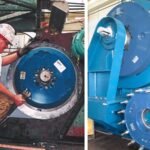Demystifying Tier 4 Final Emission Standards for Construction Equipment
In today’s world, where environmental concerns are at the forefront of many industries, the construction sector faces increasing pressure to reduce its impact on air quality. As a result, governments worldwide have introduced stringent emission regulations for construction equipment. Among these, Tier 4 Final emission standards are one of the most critical and ambitious mandates that aim to significantly curtail pollutants emitted by construction equipment. In this blog, we will delve into the world of Tier 4 Final emission standards and understand their significance, impact, and the technologies driving their implementation.
Understanding Emission Standards:
Emission standards are regulatory benchmarks set by governments to control the amount of harmful pollutants released into the atmosphere. Construction equipment, including excavators, bulldozers, loaders, and more, have traditionally been notorious for emitting large quantities of pollutants such as nitrogen oxides (NOx), particulate matter (PM), carbon monoxide (CO), and hydrocarbons (HC). These emissions contribute to air pollution and pose severe health and environmental hazards.
The Evolution of Tier Standards:
The United States Environmental Protection Agency (EPA) has been at the forefront of introducing and revising emission standards for off-road diesel engines used in construction equipment. The Tier standards were introduced in 1996, and since then, there have been several iterations leading up to Tier 4 Final, which is the most stringent stage of emission regulations.
The Tier 4 Final Journey:
Tier 1 to Tier 3: The initial phases of the Tier standards focused on reducing nitrogen oxides (NOx) and hydrocarbon (HC) emissions. This involved the implementation of advanced engine technologies and after-treatment systems like diesel oxidation catalysts (DOCs) and diesel particulate filters (DPFs).
Tier 4 Interim/Stage IIIB: In this phase, emission standards aimed to reduce both NOx and particulate matter (PM) emissions further. Construction equipment manufacturers began employing selective catalytic reduction (SCR) technology, which used a urea-based additive (DEF or AdBlue) to convert NOx into harmless nitrogen and water vapor.
Tier 4 Final/Stage IV: The latest and most stringent phase of emission standards, Tier 4 Final, aims to cut down on NOx and PM emissions even further. This necessitated the integration of highly sophisticated engine systems and advanced exhaust after-treatment technologies. Some manufacturers adopted a combination of cooled exhaust gas recirculation (EGR) and SCR technology to achieve compliance.
Impact and Benefits:
The implementation of Tier 4 Final emission standards has had a profound impact on the construction equipment industry and the environment.
- Cleaner Air: The reduction in harmful emissions, such as NOx and PM, leads to improved air quality, which positively impacts public health and the environment.
- Technological Advancement: Meeting the stringent standards necessitated innovative advancements in engine design, exhaust after-treatment, and fuel efficiency, resulting in more robust and environmentally friendly construction equipment.
- Global Adoption: The success and effectiveness of Tier 4 Final standards in the United States have inspired many countries worldwide to adopt similar emission regulations for their construction equipment.
- Sustainable Development: By promoting the use of low-emission and fuel-efficient construction equipment, Tier 4 Final standards align the construction sector with broader sustainability goals.
Conclusion:
The implementation of Tier 4 Final emission standards represents a significant milestone in the construction equipment industry’s journey toward environmental responsibility. By reducing harmful pollutants and fostering technological innovation, these standards have contributed to cleaner air and sustainable development. While the initial shift to meet the standards may have posed challenges for manufacturers and contractors, the long-term benefits to society and the environment make it a vital and necessary endeavor. As we move forward, it is crucial for the industry to continue embracing innovation and environmentally conscious practices to build a greener and more sustainable future.
















